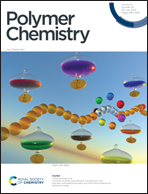Metal-free polycyclotrimerization of trimethylsilyl-protected diynes: a facile strategy toward regioregular hyperbranched polyarylenes†
Abstract
Exploration of efficient polymerization strategies is critical in polymer science. Alkyne polycyclotrimerization reactions have become powerful synthetic tools for constructing hyperbranched polyarylenes (hb-PAs). However, most of the polymerization reactions suffer from the requirement of using transition metal catalysts, and yield mixtures of 1,2,4- and 1,3,5-trisubstituted benzene isomers in their products. In this work, we provide the first example of metal-free polycyclotrimerization of internal diynes to synthesize regioregular hb-PAs. The polymerizations of trimethylsilyl-protected aromatic diynes (1a–e) proceeded smoothly in the presence of p-toluenesulfonic acid monohydrate, producing soluble hb-PAs, hb-P1a–e, with high molecular weights (Mw up to 32 200) and perfect 1,3,5-regioregularity in satisfactory yields. The degree of branching of hb-P1e was calculated to be 0.68. The polymerization reaction was insensitive to moisture and oxygen. The hb-PAs exhibited high thermal stabilities with 5% weight loss at temperatures up to 391 °C and electrochemical activities. Moreover, the hb-PAs containing tetraphenylethene moieties are weakly emissive in solution but highly fluorescent in the aggregated state, displaying aggregation-induced emission properties.



 Please wait while we load your content...
Please wait while we load your content...